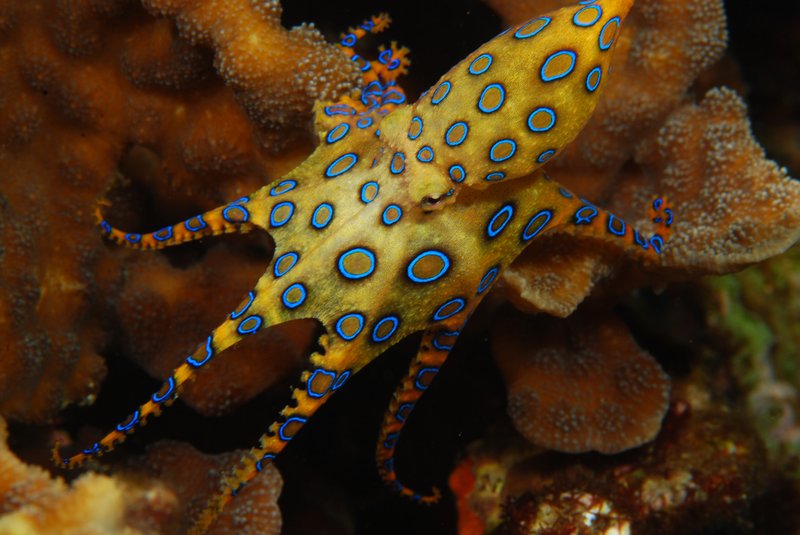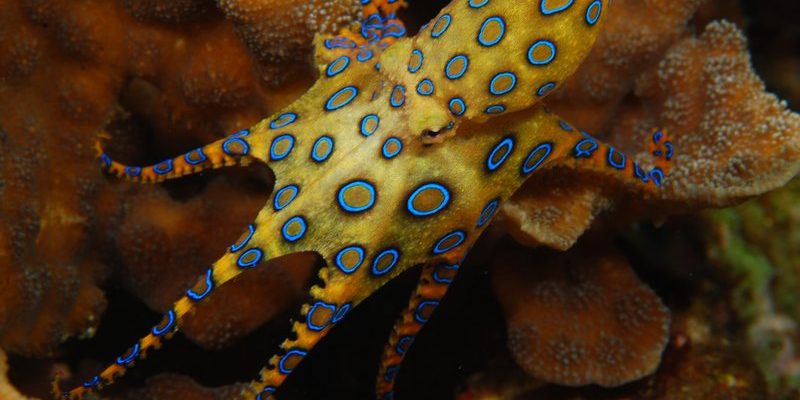
But let’s not get too ahead of ourselves. To truly appreciate how the blue-ringed octopus navigates and communicates, we need to dive into its world, exploring not just its environments but also the unique adaptations that help it survive and thrive. So grab a cozy drink, and let’s take a closer look!
Where Do Blue-Ringed Octopuses Live?
The blue-ringed octopus primarily inhabits the shallow waters of the Pacific and Indian Oceans, often found in coral reefs and rocky crevices. These areas provide a rich hunting ground with plenty of small crustaceans and fish for the octopus to snatch up. You might be wondering why these octopuses choose such habitats. Well, it’s all about *safety* and *food*.
These octopuses prefer environments where they can hide from larger predators while also having easy access to prey. The camouflage skills of the blue-ringed octopus are impressive. They can change their skin color and texture to blend in seamlessly with their surroundings. Picture them like little underwater chameleons!
How Do Blue-Ringed Octopuses Navigate Their Environment?
Navigating through their underwater world is no simple task; it involves a combination of keen eyesight, spatial awareness, and sophisticated motor skills. Blue-ringed octopuses have excellent vision, which helps them spot predators and prey from a distance. This is crucial because while these octopuses are small, they face substantial threats from larger marine animals.
Their ability to squeeze into tight spaces is another unique advantage. With no bones, they can easily change shape to fit into crevices that provide protection. It’s like having the flexibility of a yoga instructor! This adaptability not only helps them evade predators but also allows them to explore various hunting grounds.
Communication: The Colorful Language of Blue-Ringed Octopuses
One of the most astonishing aspects of the blue-ringed octopus is its ability to communicate visually. When threatened, these octopuses display bright blue rings, warning potential predators of their venomous capabilities. It’s a dramatic form of signaling that says, “Hey, stay away from me!”
But it’s not just about defense. They also use body language and color changes to communicate with each other. Imagine a conversation where the speakers change colors and shapes to express their feelings. Fascinating, right? This visual communication is essential, especially during mating rituals or territorial disputes.
Effective Camouflage: A Navigational Tool
Camouflage plays a significant role in both navigation and communication for blue-ringed octopuses. They can change the texture and color of their skin to blend into their environment. When they want to escape notice, they might take on the appearance of a rock or coral.
This ability not only helps them avoid predators but aids in their hunting strategies as well. By remaining hidden, they can ambush unsuspecting prey. Here’s the thing: effective camouflage is like having a built-in stealth mode, allowing the octopus to navigate its habitat without drawing unwanted attention.
The Role of Intelligence in Navigation and Communication
Let’s talk about intelligence. Blue-ringed octopuses are considered highly intelligent for their size. They’ve been observed solving problems, which is a sign of advanced cognitive abilities. This intelligence plays a vital role in their navigation through complex underwater environments.
For example, they can remember locations where food is plentiful and return to those spots later. This ability to learn and adapt enhances their survival chances. In terms of communication, their intelligence allows them to interpret visual signals from other octopuses, increasing their chances of forming successful social interactions.
How Do They Use Their Environment for Communication?
The blue-ringed octopus doesn’t just communicate in a vacuum; it uses its environment as a stage. For instance, when displaying its blue rings, the surrounding colors and textures can enhance the visual impact of the message. This means that the context can either amplify or dilute the communication attempts. So, the next time you see one of these intriguing creatures, remember that every color displayed might be telling a specific story!
In addition, the structure of their habitat plays a role. For instance, an octopus stationed near a vibrant coral reef may use the bright colors to signal others more effectively than if it were in a dull sandy area. It’s a dynamic interplay of communication and environment that showcases nature’s creativity.
Why Understanding Their Navigation and Communication Matters
You might be wondering why all this matters. Understanding how the blue-ringed octopus navigates and communicates provides insights into marine ecosystems and the intricate relationships between species. This knowledge can help researchers develop better conservation strategies to protect these incredible creatures and their habitats.
Furthermore, studying these unique forms of communication broadens our understanding of animal behavior and intelligence. It opens up new avenues for research that could even inform robotics and artificial intelligence by mimicking how these octopuses interact with their world.
In conclusion, the blue-ringed octopus is not just a beautiful creature; it’s a master navigator and communicator of the ocean. By understanding how they move and talk, we gain a deeper appreciation for the complexity of underwater life and the delicate balance of marine ecosystems. Let’s keep our oceans healthy, so these incredible little octopuses can continue to thrive!

